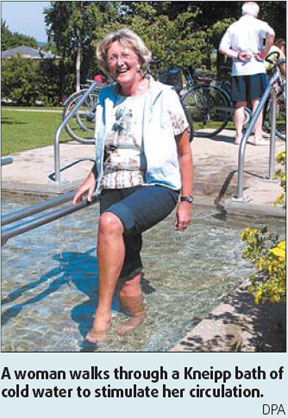Flood of new interest in simple water therapy
BERLIN: Most Germans have heard of Father Kneipp. Whether hydrotherapy, herbal tea, light foods or long walks come to mind, there are a lot of things attributed to 19th century Bavarian priest Rev Sebastian Kneipp, although initially at least, he advocated chiefly the utilization of hot and cold water to boost the health of sickly people.
The teachings of the "water doctor" used to be the theoretical basis of a classic Kneipp spa treatment, but now his findings have spread to other health practices and preventive medicine.
"Kneipp is experiencing a small renaissance," says Christoph Menne of the German medical "wellness" association in Berlin. An apparent reason is many people are going back to the roots. "Kneipp's water treatments are the basis for many other practices."

The practices also are downright simple. Kneipp, a former tradesman, who began studying theology at age 27, had serious lung disease. By immersing himself in the ice-cold Danube river, he healed himself and the experience led to a healing method based on warm and cold, says Professor Juergen Kleinschmidt of the University of Munich.
Kleinschmidt says these brief stimulative thermo-therapies caused the blood vessels to contract and expand and thus improve circulation. Another practice is alternating warm and cold water poured over the body.
About 120 different variations have been developed from pouring water over the thighs to pouring it over the face. It is done to stimulate the circulation and relax tight muscles.
Water exercises, including stepping in knee-deep water, also helps the arteries in the legs contract. "That's good for people with vein problems, because the valves in the veins get into gear," says Kleinschmidt.
The 160,000-member Kneipp Association, still with its offices where Kneipp worked, in Bad Woerishofen, has identified five elements that make Kneipp's methods different. In addition to the hydrotherapy, there is modest exercise, a wholesome diet, herbal medicine and the so-called order therapy, which is based on psychological balance.
"Kneipp said what every priest or general practitioner said: Stay calm, go to bed early and so on," says Kleinschmidt.
Later the teachings were broken out into specialties, such as the Kneipp swimming pool attendant and the Kneipp doctor. Today there are about 70 Kneipp spas in Germany, says Kleinschmidt.
After a sharp decline in spa attendance, they focus more on "wellness", says Monika Siegl of the Kneipp institute in Bad Woerishofen. The first Kneipp hotel was certified in autumn 2007 as a facility offering a health pick-up. The hotel is called the Kneipp, a name protected by trademark.
"Above all we want to get families enthused," says Siegl.
The Kneipp Association also is modernizing.
"Every association is, of course, independent, and meanwhile, yoga and Nordic walking are among the activities offered," says spokeswoman Evamarie Subhi. New trends are always being integrated according to the motto: "What's healthy does good and fits in."
Kneipp's work with children also has intensified. There now are 134 Kneipp kindergartens in Germany. An example of a standard at these facilities is a herb garden, and the children are taught to consciously experience the seasons and to prepare healthy meals.
DPA
(China Daily 02/27/2008 page19)














